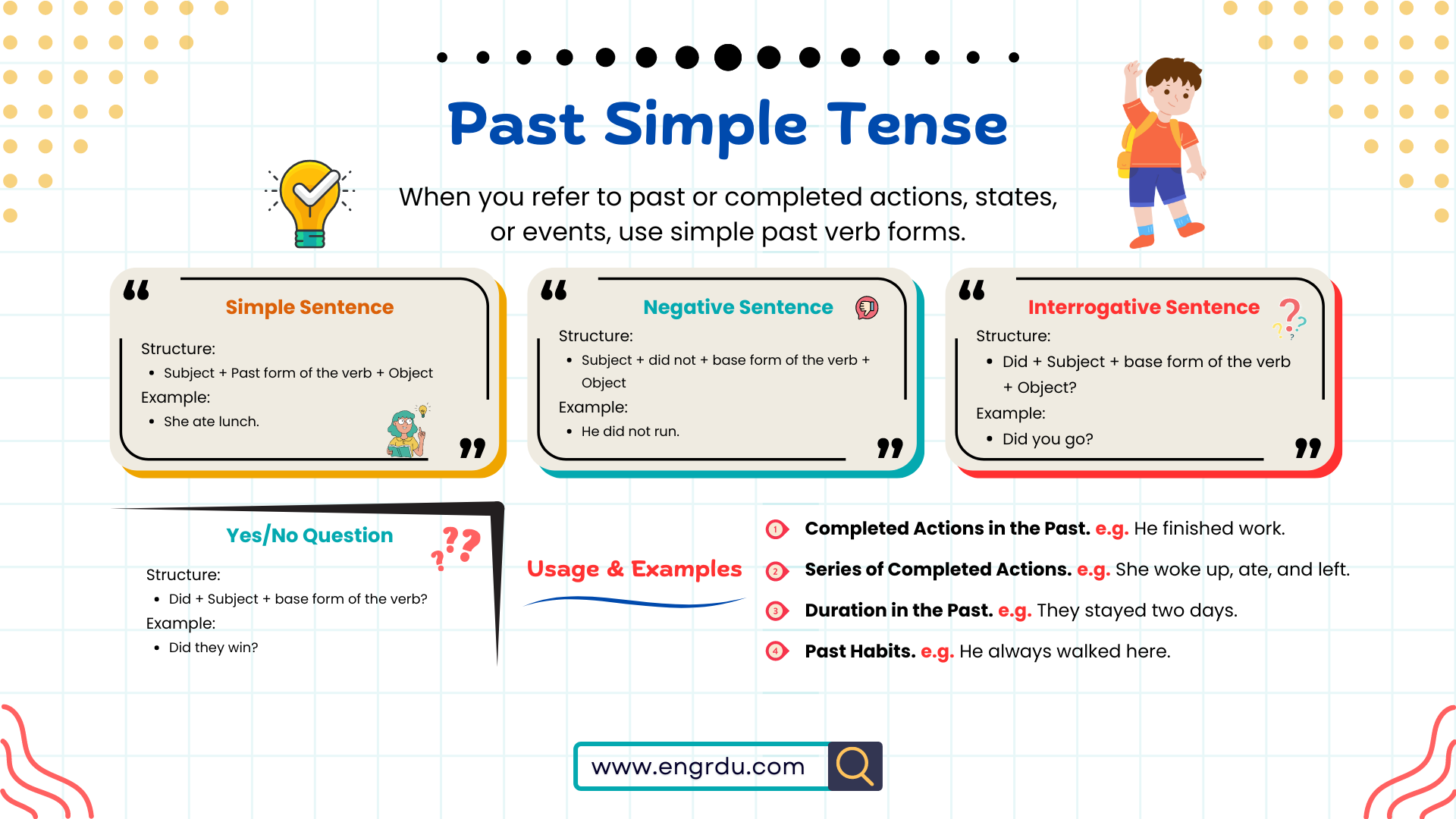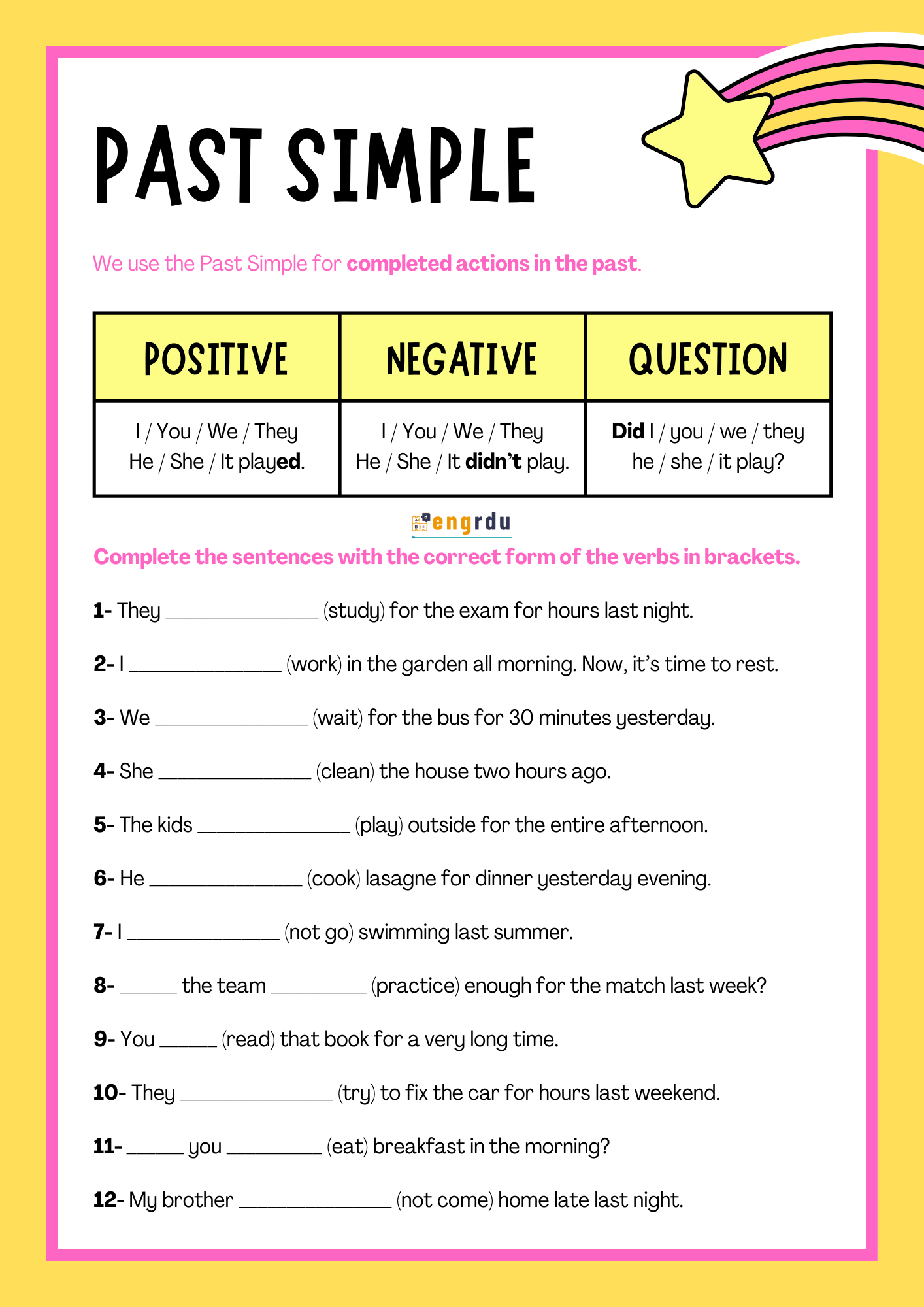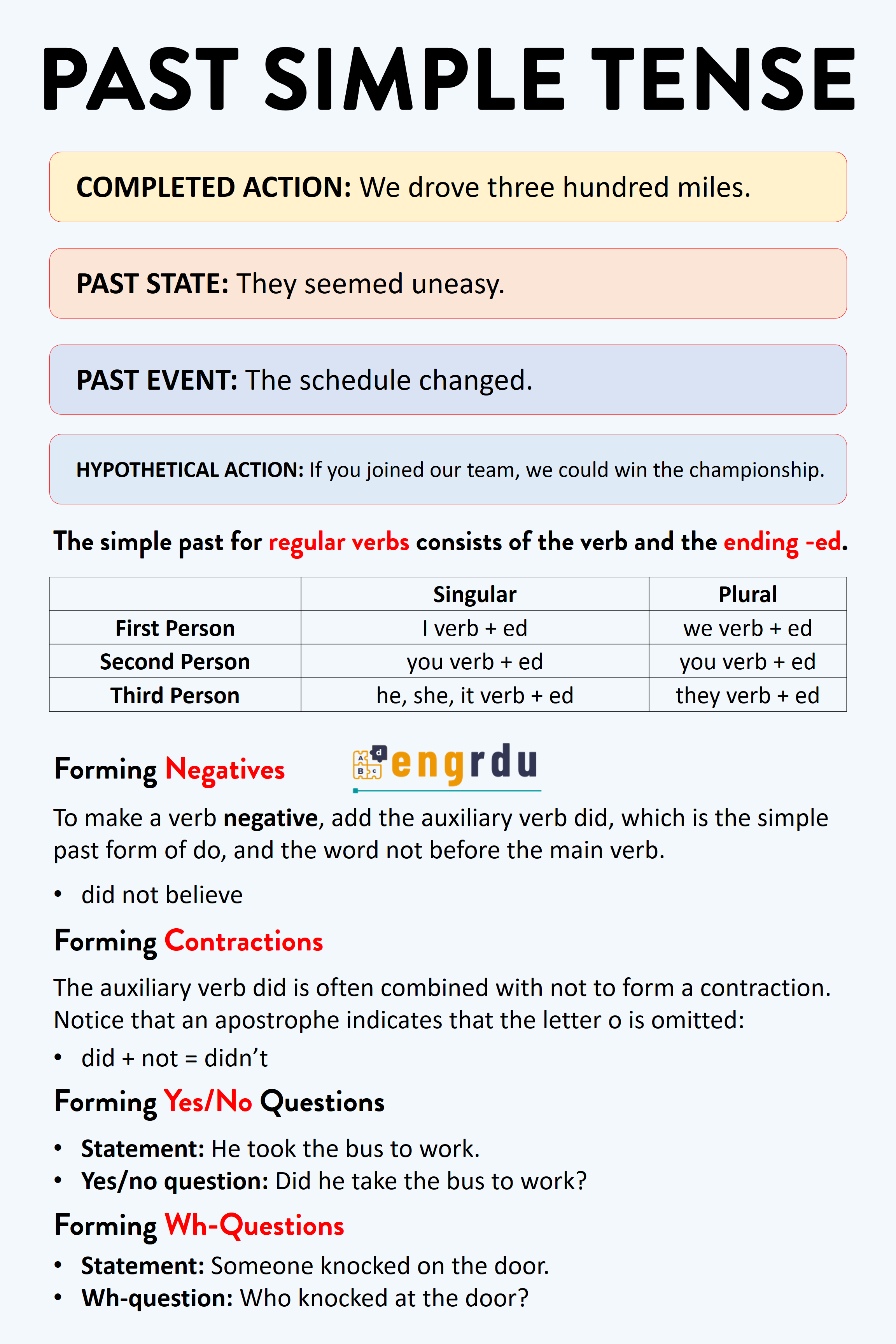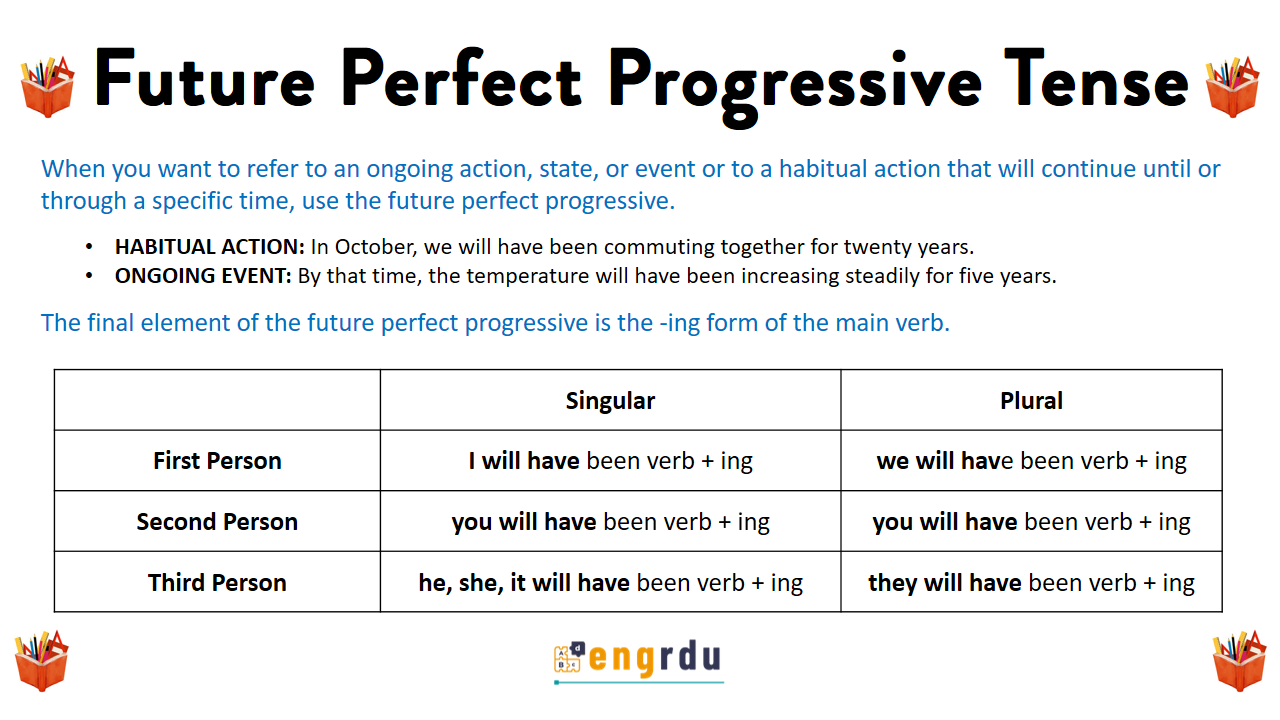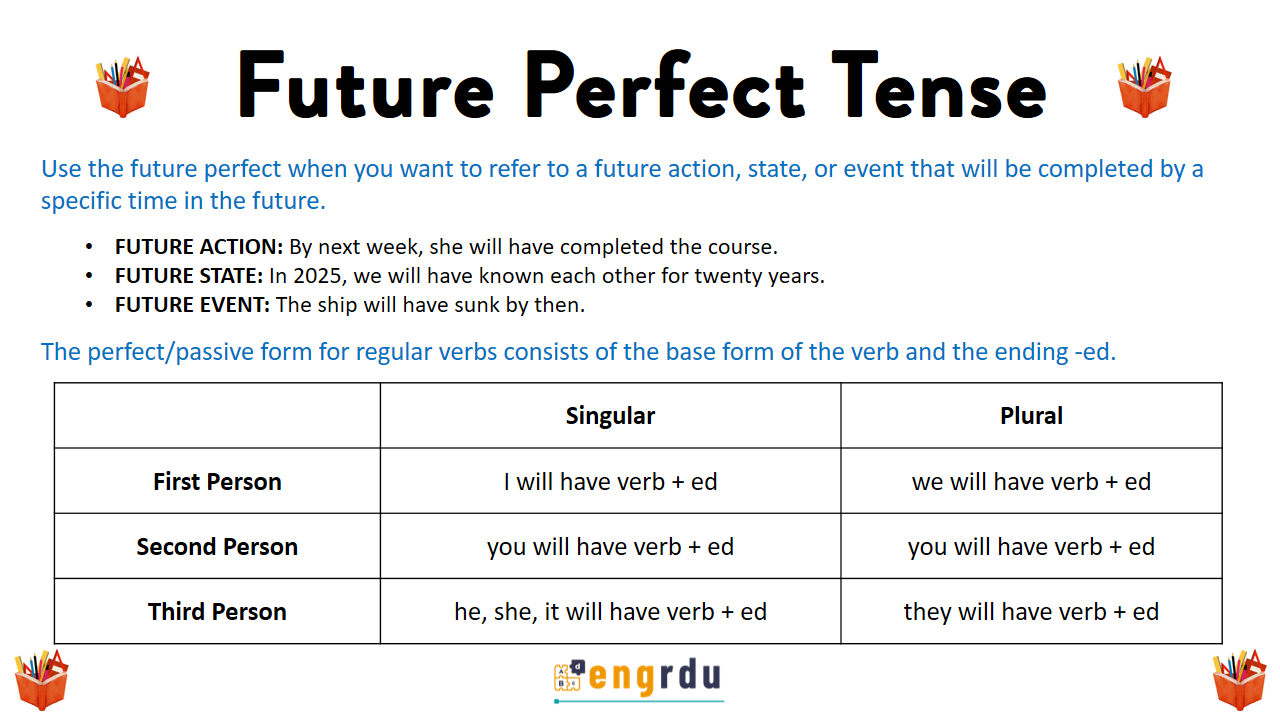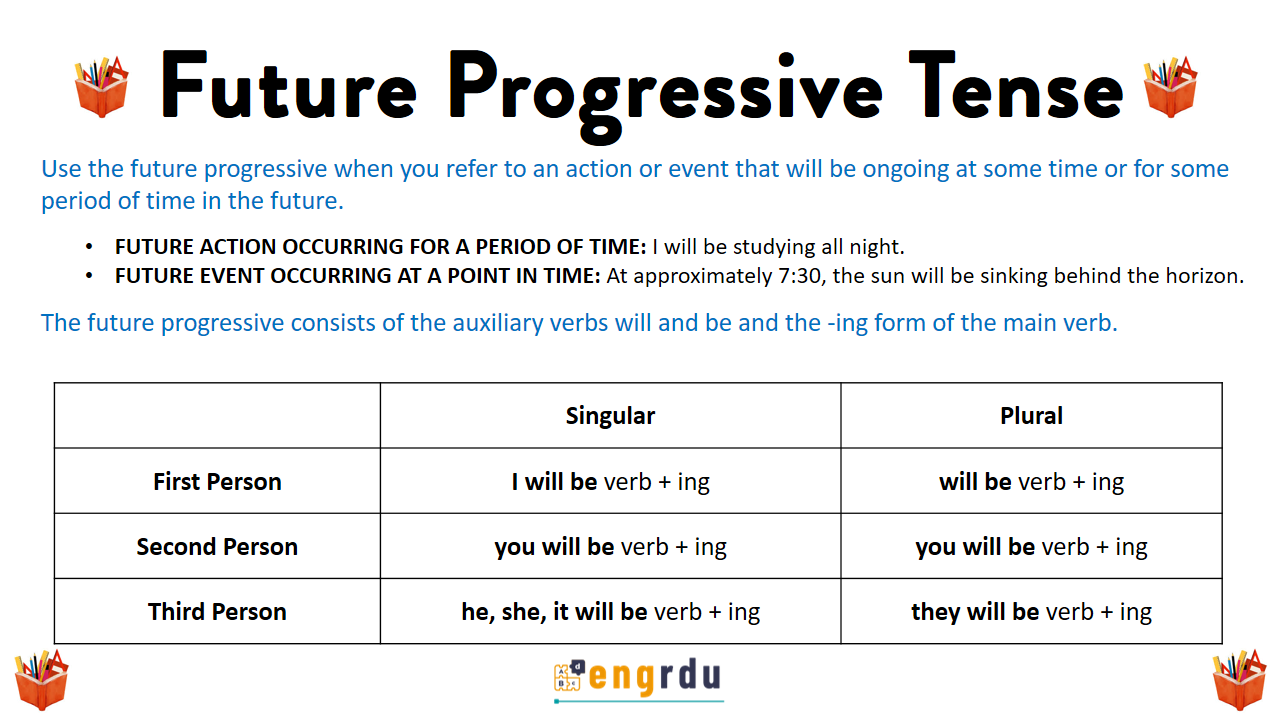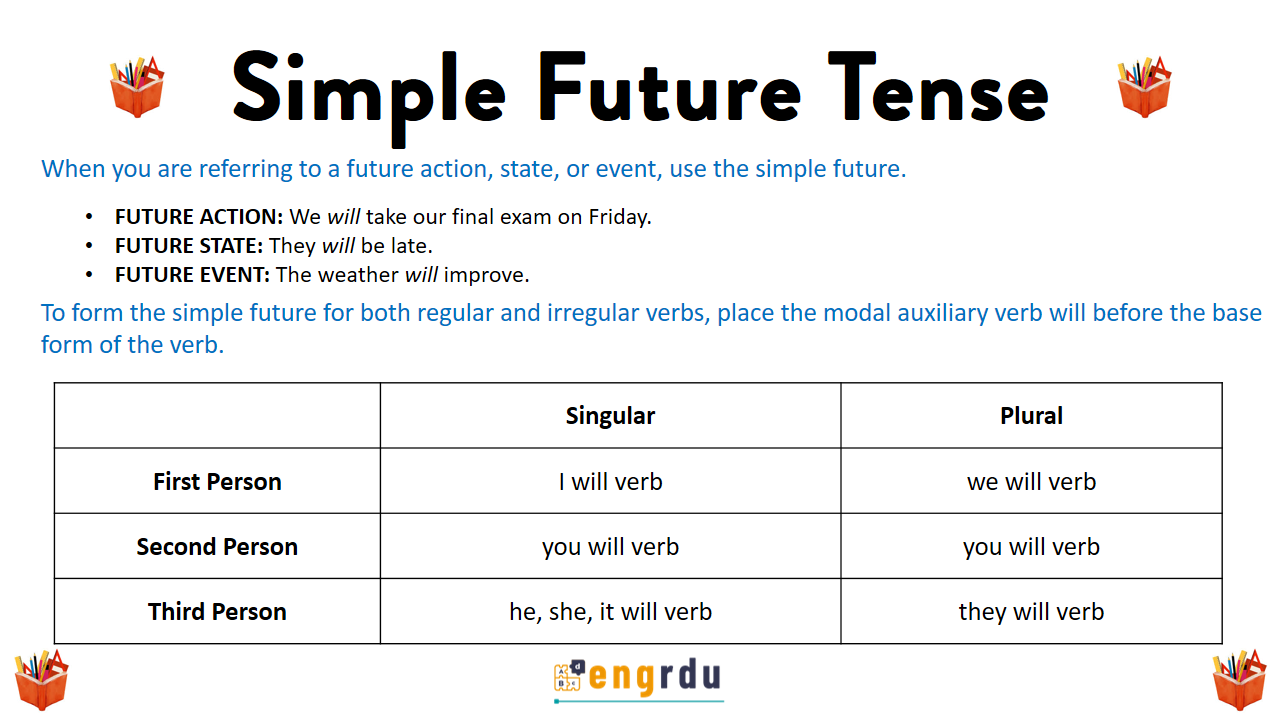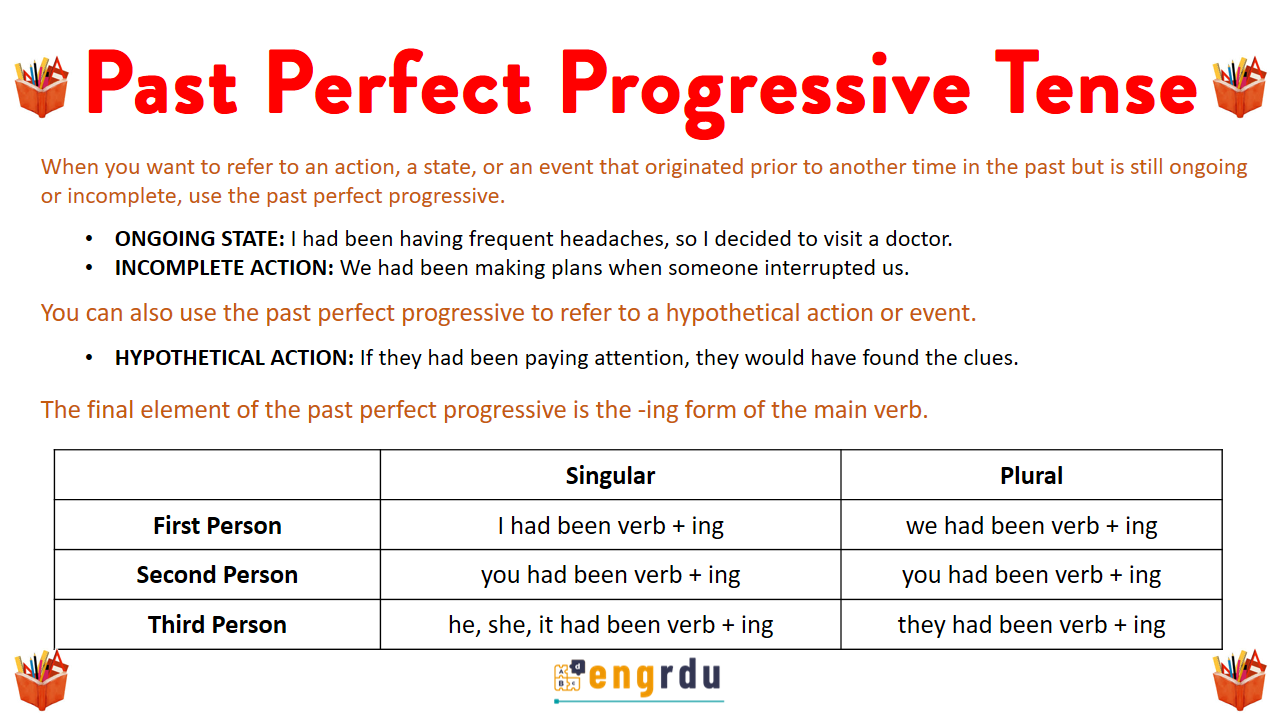Learn the definition, rules, usage, formulas, example sentences, and practice exercises of the past simple tense in English. Learn the entire lesson and boost your English grammar learning skills.
Past Tense in English
Verbs in the past tense occur in four forms, each signaling a different aspect. These forms convey information about actions, states, or events that are remote in the speaker’s mind. The past tense most often refers to past time.
- SIMPLE PAST: I waited patiently.
- PAST PROGRESSIVE: I was waiting for a bus.
- PAST PERFECT: I had waited long enough.
- PAST PERFECT PROGRESSIVE: I had been waiting for three hours.
In the following units, you will learn about these verb forms and the reasons for using them.
Simple Past Tense in English
When you refer to past or completed actions, states, or events, use simple past verb forms.
- COMPLETED ACTION: We drove three hundred miles.
- PAST STATE: They seemed uneasy.
- PAST EVENT: The schedule changed.
You can also use the simple past to refer to a hypothetical action, state, or event.
- HYPOTHETICAL ACTION: If you joined our team, we could win the championship.
The simple past for regular verbs consists of the verb and the ending -ed.
| Singular | Plural | |
| First Person | I verb + ed | we verb + ed |
| Second Person | you verb + ed | you verb + ed |
| Third Person | he, she, it verb + ed | they verb + ed |
For regular verbs, the simple past form and the perfect/passive form are the same.
When a one-syllable word or a word with a stressed final syllable ends in a single consonant sound, double the last letter before adding -ed.
- One-syllable word: plan ➞ planned
- Word ending in a stressed syllable: occur ➞ occurred
- BUT row ➞ rowed [This word ends in a vowel sound.]
The following are common irregular verb patterns: some of these irregular simple past forms are the same as the perfect/passive forms.
• Pattern 1: The final d becomes a t. (Same as perfect/passive)
- send ↔ sent
- lend ↔ lent
- spend ↔ spent
• Pattern 2: A -d or -t suffix is added. The vowel changes. (Same as perfect/passive)
- feel /fil/ ↔ felt /fElt/
- sleep /slip/ ↔ slept /slEpt/
- tell /tEl/ ↔ told /told/
• Pattern 3a: The vowel changes. (Different from perfect/passive)
- eat /it/ ↔ ate /et/
- speak /spik/ ↔ spoke /spok/
- know /no/ ↔ knew /nu/
• Pattern 3b: The vowel changes. (Same as perfect/passive)
- hold /hold/ ↔ held /hEld/
- meet /mit/ ↔ met /mEt/
- sit /sIt/ ↔ sat /sAt/
• Pattern 4: The base form and the simple past form are the same. (Same as perfect/passive)
- put ↔ put
- hit ↔ hit
- cut ↔ cut
Forming Negatives
To make a verb negative, add the auxiliary verb did, which is the simple past form of do, and the word not before the main verb.
Negative Sentence Structure:
- Subject + did not + base form of the verb + Object
Example:
- He did not run.
- He did not believe us.
Forming Contractions
In English, verbs are often combined with other words to form contractions. These shortened forms include an apostrophe (’) to indicate missing letters. It is important to learn contractions because you will often hear them in conversation or see them in informal writing. Formal writing, though, rarely contains contractions.
The auxiliary verb did is often combined with not to form a contraction. Notice that an apostrophe indicates that the letter o is omitted:
- did + not = didn’t
Forming yes-or-no Questions
To form questions that can be answered yes or no (yes/no questions), begin the question with the auxiliary verb did. After the auxiliary verb, place the subject and the main verb.
Structure:
- Did + Subject + base form of the verb + Object?
Example:
Did you go?
- Statement: He took the bus to work.
- Yes/no question: Did he take the bus to work?
Forming Wh-Questions
Wh-questions are used to elicit specific pieces of information. They usually begin with what, who, why, where, when, how, or combinations such as how much, how many, and how often. When the question word is the subject of the sentence, the form of the question is similar to the form of a statement.
- Statement: Someone knocked on the door.
- Wh-question: Who knocked at the door?
When the question word is any other part of the sentence, the auxiliary verb did comes after the question word and is followed by the subject and the main verb.
- Statement: She bought a new cell phone.
Wh-question: What did she buy? - Statement: They left last night.
Wh-question: When did they leave?
Be Verb Forms, Simple Past Tense
The verb be has two different forms in the simple past: was and were.
| Singular | Plural | |
| First Person | I was | we were |
| Second Person | you were | you were |
| Third Person | he, she, it was | they were |
The word there is often used with the verb be to acknowledge the existence of someone or something. The form of the verb is based on the subject that follows it.
- Singular subject: There was a storm last night.
- Plural subject: There were twelve people in the cast.
Forming Negatives
To make the verb be negative, just add not.
- was not
- were not
Forming Contractions
In conversation and informal writing, you can use contractions.
- was not = wasn’t
- were + not = weren’t
Forming yes-or-no Questions
To form yes-or-no questions, begin the question with the form of the verb be and place the subject after it.
- Statement: John was late.
Yes/no question: Was John late? - Statement: They were surprised.
Yes/no question: Were they surprised?
To form yes/no questions with there, place there after the be verb.
- Statement: There was a message for Natalie on the answering machine.
- Yes/no question: Was there a message for Natalie on the answering machine?
Forming Wh-Questions
To form wh-questions, place the be verb after the question word. When the question word is the subject of the sentence, the form of the question is similar to the form of a statement.
- Statement: Cindy was the winner.
- Wh-question: Who was the winner?
When the question word is any other part of the sentence, the subject follows the be verb.
- Statement: They were in Mexico last week.
Wh-question: Where were they last week? - Statement: She was in the office on Tuesday.
Wh-question: When was she in the office?
Simple Past Tense Exercise
Exercise-1
Complete each sentence with the simple past form of the verb in parentheses. The first five verbs are regular; the second five are irregular.
1. We ———— (work) hard all day.
2. The fans———— (wait) in line for tickets.
3. I ———— (remember) her face.
4. He ———— (need) a computer upgrade.
5. She ———— (miss) class now and then.
6. They ———— (sell) some of their land.
7. Chen ———— (go) to work at 3:00.
8. Tim and Andrea first ———— (meet) at a mutual friend’s party.
9. I accidentally ———— (cut) my finger.
10. Everyone at the party ———— (wear) a costume.
Exercise-2
Complete each sentence with either the simple past or the present perfect. Remember that the simple past indicates completion, while the present perfect indicates continued relevance.
1. Joe and Donna ———— (live) here in the 1990s.
2. Joe and Donna ———— (live) here since the 1990s.
3. Maria and I ———— (study) together for two years. We meet in the library every Wednesday night at 7:00.
4. Maria and I ———— (study) together last year.
5. We ———— (travel) to London in April.
6. We ———— (travel) to many countries, but this year we’re staying home.
7. I ———— (work) for Safeway since May.
8. I ———— (work) for Safeway in 2015.
9. He ———— (build) many houses. He is currently building one on Madison Street.
10. He ———— (build) a house for his sister.
Exercise-3
Make each of the following sentences negative.
EXAMPLE:
- I made a mistake.
- I did not make a mistake.
1. He came to work on time.
2. My roommate liked the movie.
3. She understood the problem.
4. We took a wrong turn.
5. The students needed help with the homework.
6. The driver blamed me for the accident.
7. I listened to the directions.
8. She earned a degree in economics.
9. He calculated the taxes.
10. They complained about the weather.
Exercise-4
Rewrite the following statements as yes/no questions.
EXAMPLE:
- You finished your application letter.
- Did you finish your application letter?
1. They elected a new president.
2. She delivered the report.
3. You expected us earlier.
4. Tho passed his driver’s test.
5. The committee explored the issues.
6. He explained the problem.
7. The director had an appointment at 3:00.
8. You forgot the map.
9. The bank lent him some money.
10. They offered him a job.
Exercise-5
Complete the following questions based on the statements provided:
EXAMPLE:
- He found the missing document on the top shelf.
- Where did he find the missing document?
1. Toni Morrison wrote Beloved.
Who ————
2. Patty won the contest.
Who ————
3. He turned left.
Which way ————
4. They traveled to four different countries.
How many countries ————
5. You taught biology for thirty years.
How long ————
6. The repair cost $35.00.
How much ————
7. They stayed at the party until midnight.
How long ————
8. She ran fifteen miles.
How far ————
9. They moved to Hong Kong.
Where ————
10. They climbed to the summit.
How far ————
Past Tenses
- Past Progressive Tense in English
- Past Perfect Tense in English
- Past Perfect Progressive Tense in English
Present Tenses
- The Simple Present Tense in English
- Present Progressive Tense In English
- Present Perfect Tense in English
- Present Perfect Progressive Tense in English

